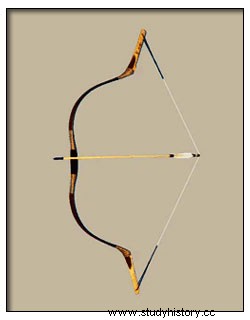Mongol armies of the 13th century

If the armament of the Mongols largely remained in the shadow of the conquests, it is thanks to him, and to original tactics, that the Mongol successes were possible. The Mongols had only two main weapons:the spear and the bow. Maces and sabers were only used as a last resort. Mongolian spears are often equipped with a hook to unhorse the opponent. The Mongolian bow is the weapon of the steppe par excellence.
It is, with a few material differences, the same bow that already equipped the Scythians and the Parthians. It is a composite bow, with double curvature. With a maximum range of 150 to 200 m. (at this distance the arrow is no longer dangerous), it was able to pierce Western armor at 75 m. This weapon had only distant similarities with the English longbow. Indeed, the Mongolian bow is a particularly difficult weapon to produce, it requires a number of different materials, such as buffalo horn, tendons, different kinds of wood, etc. and experienced craftsmen.
This relatively fragile weapon feared humidity and shocks. The Mongols carried the bow in a case, worn permanently on the belt, as well as a quiver containing about 60 arrows.
The irons, brought to the red, were immersed in salt water, in order to increase their resistance. There were also whistle arrows, to transmit signals.
If the defensive equipment of the light cavalry was limited at best to a leather helmet, sometimes covered with metal plates, the Mongols had armor, often lacquered leather, and iron for the richest. Later, pieces of armor will be collected from defeated peoples. In general, these armors were composed of lacquered leather strips overlapping each other. Probably lighter than the European models, they were however inconvenient. Underneath, the Mongols liked to wear wide shirts of raw silk, which, it is said, had the peculiarity, in case of injury, to enter the wound with the arrow. It was enough, it is said, to pull on the tails of the shirt to extract the iron from the arrow.
The witnesses also mention the presence of shields, but these are only carried by the sentries, and even then, at night. Heavy cavalry horses were protected by leather and metal armor. Iron plates guarded the foreheads of the horses.
The Mongol standards were of two kinds:the tuk (standards) and the süld (ensigns) which consisted of a staff on which one fixed yak or horse tails. The black standard was used in war, and the white in peacetime. The number of queues ranged from three to nine, the latter number being in principle reserved for the emperor (Khan). However, the Khan is also reputed to have had a personal standard, called xôx tuk, 'blue standard', struck with a white falcon, emblem of his family clan
Reflex Bow
A reflex arc is an arc that is slightly recurved at its ends. However, it is different from the recurve bow.
When the bow is drawn, the bends help create greater force allowing an arrow to be fired at a faster speed without significantly adding weight or size to the bow.
This form of bow puts the bow under increased stress and the materials composing it must be of high quality.
When unwrapped, the whole bow curves forward, with the center pointing away from the archer, forming an upside-down “C”; this differentiates a reflex bow from a recurve bow.
This type of bow was used extensively by the nomadic tribes of Central Asia (notably the Parthians, Mongols and Turks) and the Magyars until the introduction of firearms.
